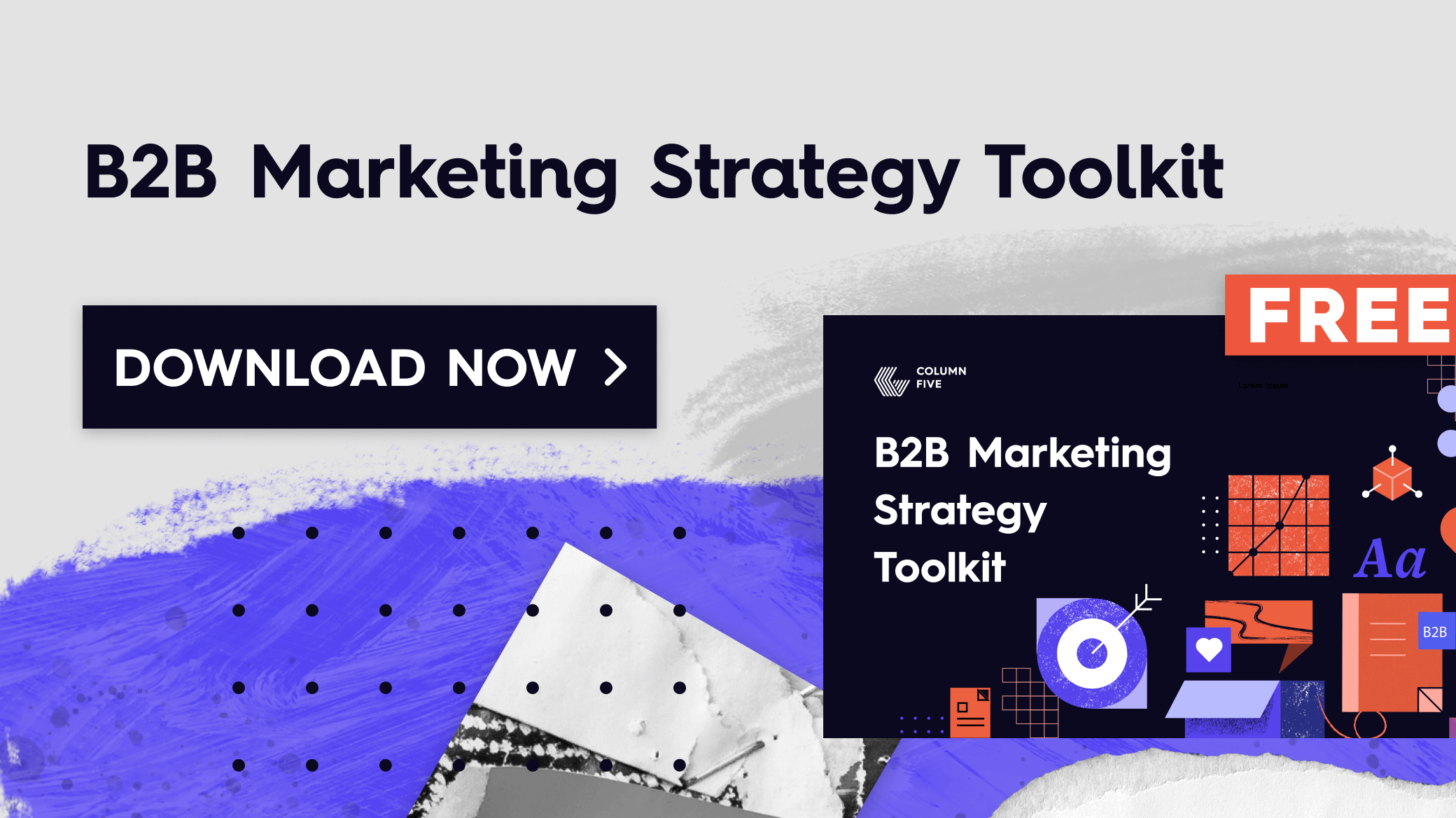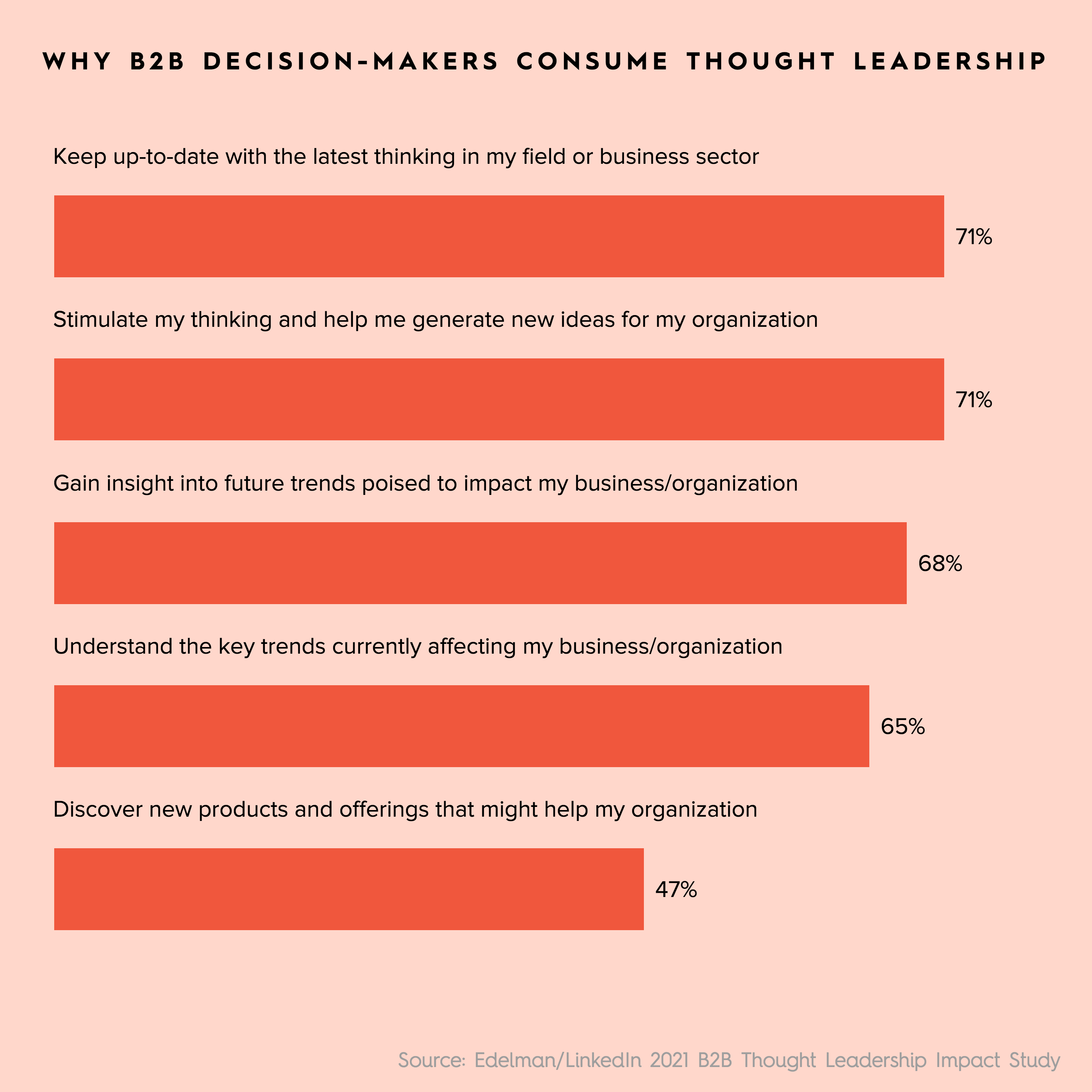Although the mantra of the last decade has been “Content Is King,” we say brands should create less content (if they don’t have their brand in order). You may balk at that idea, but as the Edelman/LinkedIn 2021 B2B Thought Leadership Impact Study proves, audiences don’t necessarily want more B2B thought leadership; they just want it to be better. But what does that really look like? Today, we’re breaking down the biggest insights from this fascinating report to give you the tips you need to create the right content for your audience—and outshine your competition while you do it.

The State of B2B Thought Leadership
No one can deny that the market has become oversaturated in recent years. (And by “the market,” we mean just about every market that exists in B2B.) According to the Linkedin/Edelman report, which polled B2B decision-makers and C-suite executives, there are three main frustrations that audiences face when it comes to B2B thought leadership.
- They’re overwhelmed. Your audience is wading through more content than ever; 66% say the pandemic spawned a huge increase in the amount of thought leadership in the marketplace.
- They’re busy. With little time to waste, 55% of decision-makers say that if a piece of thought leadership does not pique their interest within the first minute, they will move on.
- They’re unimpressed. Most thought leadership is lacking; 71% of decision-makers say that less than half of the content they consume gives them valuable insights.
And yet, they desperately want content. In fact, 51% of C-Suite executives say they spend more time-consuming thought leadership than before the pandemic began, as content plays an incredibly valuable role in their jobs.

And, naturally, good content massively influences the buying process, as 64% of buyers say that an organization’s thought leadership content is a more trustworthy basis for assessing its capabilities and competency than its marketing materials and product sheets.
But how do you create less-but-better content that actually helps your audience, creates momentum, and moves them down the path to purchase?
5 Ways to Create Less But Better B2B Content
You can easily use turn these insights into action by heavily vetting every idea you have, adding more value to every piece you create, and packing it full of personality. If you’re not sure where to start, try these tips.
1) Find that emotional hook.
You want to pique interest in the first minute, starting from the headline.
- Speak to a pain point or problem. 63% of buyers also say that thought leadership is important in providing proof that an organization genuinely understands or can solve their specific business challenges. If you can demonstrate empathy, they will feel seen and understood.
- Say something provocative. Taking a strong stance can communicate the confidence and authority you need to cultivate trust. (Heck, we’re a marketing agency that started this piece by telling you to create less marketing.)
- Be human. Speak to people like people and you will build a much stronger relationship.
Tip: Use Coschedule’s headline analyzer to infuse more emotion into your headlines.
2) Use data for credibility.
Whether you’re entering a new market or looking to improve your authority, data storytelling can be a fantastic way to create credible content.
- Dig into your own data. Turn the numbers in your spreadsheets into interesting, unique stories that support your market positioning. Here are 9 sources of data you probably already have.
- Turn to expert sources. Here are 100+ free sources of data to create everything from articles to infographics.
- Visualize your data correctly. Data visualization can massively transform the way your audience synthesizes information. See our guide to choose the right charts and graphs to tell your data story as effectively as possible.
Tip: Use our guide to find the story in any piece of data and turn it into a great piece of content.
60% of buyers say thought leadership builds credibility when entering a new category where the brand is not already known.
–Edelman/LinkedIn 2021 B2B Thought Leadership Impact Study
3) Fill a gap in the news.
There are plenty of interesting topics, angles, and trends that mainstream media may be missing. You can serve a valuable purpose by bringing these stories to life.
- Dispel a popular myth. This is a great way to capture attention and add something interesting to a conversation in your area of expertise.
- Provide perspective on trending topics. You don’t want to newsjack or insert yourself into conversations unnecessarily, but addressing newsworthy topics can be a great way to engage with your audience and stay top-of-mind.
- Create content with publications. If you want to expand your reach, support journalists, and establish your authority, pitching ideas to publications (especially in your industry) is a win-win. Find out how to partner with publications to create original content.
Tip: Even if you’re not creating content with a publication, getting coverage for your own content is a great tactic to increase brand awareness. See our tips to promote your content like an agency would.
54% of buyers say that thought leadership is important for drawing attention to topics that news media rarely cover but are nonetheless meaningful within their industry.
–Edelman/LinkedIn 2021 B2B Thought Leadership Impact Study
4) Make it distinctly you.
People don’t want to be sold to by a corporation; they want to meaningfully engage with a brand. They want to know who you are and what you care about. Creating generic content that doesn’t showcase your personality will immediately make them move on. Luckily, there are a few easy ways to enhance your content and add the personality they want.
- Add a byline. No one trusts content from an unnamed source.
- Use your brand voice. If you don’t know what yours is, see our questionnaire to find it.
- Share your values. Show people who you are by turning your values into relevant, interesting content. For inspiration, see how these brands have done it.
Tip: Create a brand style guide to make sure everything you create accurately reflects your brand.
5) Make content that’s easy to consume.
People are busy. People are tired. People don’t have time. You can provide a tremendous service by providing content that is neat, condensed, and highly informative.
- Condense a complicated topic. Providing primer-style content is a huge help to people who want information as quickly as possible.
- Make things visual. Charts, graphs, illustrations, flowcharts, and other types of visual content can help maximize comprehension. (This is also great content to share on social channels.)
- Try different formats. Does your audience prefer articles or infographics? Podcasts or videos? Experiment with creating a healthy mix of different types of B2B content for lead gen.
Tip: Find out how to use microcontent to deliver high-value information in short-form content.
87% of buyers say that thought leadership content can be both intellectually rigorous and fun to consume at the same time.
–Edelman/LinkedIn 2021 B2B Thought Leadership Impact Study
How to Improve Your Thought Leadership Going Forward
Whether you’re building your marketing operation from scratch or looking to refine your current tactics, quality will always serve you better than quantity. So, as you continue to develop your thought leadership, keep these tips in mind to make sure you’re on the right track.
- Go back to basics. Good content starts with a good content strategy. To keep your marketing and brand goals aligned, get your team on the same page, maximize your resources, and make the most effective content possible, use our free toolkit to build a B2B marketing strategy that gets real results.
- Work with experts. One of the biggest challenges brands face is not having access to the experts needed to create high-quality content. If your brand is struggling with this problem, see our tips to find an agency with the right expertise and find out how to turn your in-house experts into content creators.
- Stay educated. Things move quickly in B2B (especially if you’re working in SaaS). Keep on top of B2B buying trends, aggressively evaluate your strategy, and tweak as needed.
Above all, focus on supporting your core team by giving them the resources and support they need to function as a mature marketing organization. Whether that’s providing helpful tools or external support, focus on doing less but better when you need to realign your marketing and we promise you’ll see better results. That said, if you need help getting the results you’re looking for, learn more about what’s it’s like to work with us on a content strategy or hit us up. We’d be happy to help you reach the right people.





